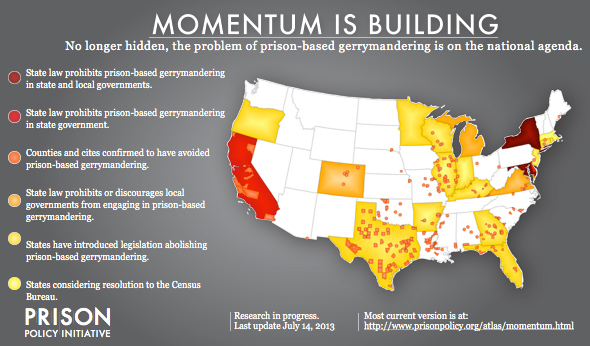200+ communities around the nation reject prison-based gerrymandering
Ever since redistricting season started, we've been researching how local governments across the country have handled the problem of prison-based gerrymandering. Our results? A clear trend away from prison-based gerrymandering.
by Leah Sakala, November 26, 2012
How do officials in cities or counties that contain large prisons draw their electoral districts? Do they accept Census Bureau data that inflates the population of the area containing the prison, or do they reject the Census Bureau’s prison counts in order to draw fair districts?
We’ve been reaching out to cities and counties across the country, first to bring the problem of prison-based gerrymandering — and the solutions — to their attention, and then more recently following up to see what they did. We’re happy to report that we’ve found that most of these cities and counties exclude the prison populations in order to give all of their actual residents the same access to government.
Just the other day, we hit a big milestone in the project when we verified the 200th county or city to refuse to engage in prison-based gerrymandering: Prison Policy Initiative Legal Director Aleks Kajstura found that Howard County, Texas refused to use the 5,000+ people in private and federal prisons when drawing its new County Commissioner precincts. Had county officials engaged in prison-based gerrymandering, the First Precinct would have been more than 60% incarcerated, giving every four residents of that precinct the same influence as ten residents in any other parts of the county.
This milestone in our research is further evidence that the national trend away from prison-based gerrymandering is gaining momentum. And even more exciting is the fact that 200 is a significant underestimate of the number of local governments that avoid prison-based gerrymandering. We know that the actual number is much higher, in part because we’re still calling counties and because redistricting is not yet complete in some locations, but especially because we’ve largely skipped following up in states that require counties and municipalities to exclude prison populations. Instead, we’ve focused on the places that must independently choose whether or not to avoid prison-based gerrymandering. And there, the trend is clear: prison-based gerrymandering is on the decline.
To celebrate reaching 200, we’ve updated our map of national progress towards ending prison-based gerrymandering:
These 200+ communities deserve the credit for finding creative solutions to the unexpected problems caused by the Census Bureau’s archaic method of tabulating incarcerated people. Unfortunately, often unknowingly, many other communities used census counts of prison populations to dilute the votes of most of their own residents. Hopefully the Census Bureau will update its methodology and present the country with a national solution by counting incarcerated people at home in 2020.





[…] its prison gerrymandering problem this time around, maybe it will in 2020. After all, there are more than 200 counties and cities around the country with prisons that decided not to use the prison populations when redrawing their district lines. To […]
[…] that contain equal numbers of actual residents. Granville should take this opportunity to join the more than 200 other local governments across the country that have decided to prevent prison counts from unfairly skewing local […]
[…] sparked legislation in eight states and passed in two, more than 200 local governments have solved the problem on their own, and the issue got news coverage in hundreds of articles and editorials including a New York Times […]